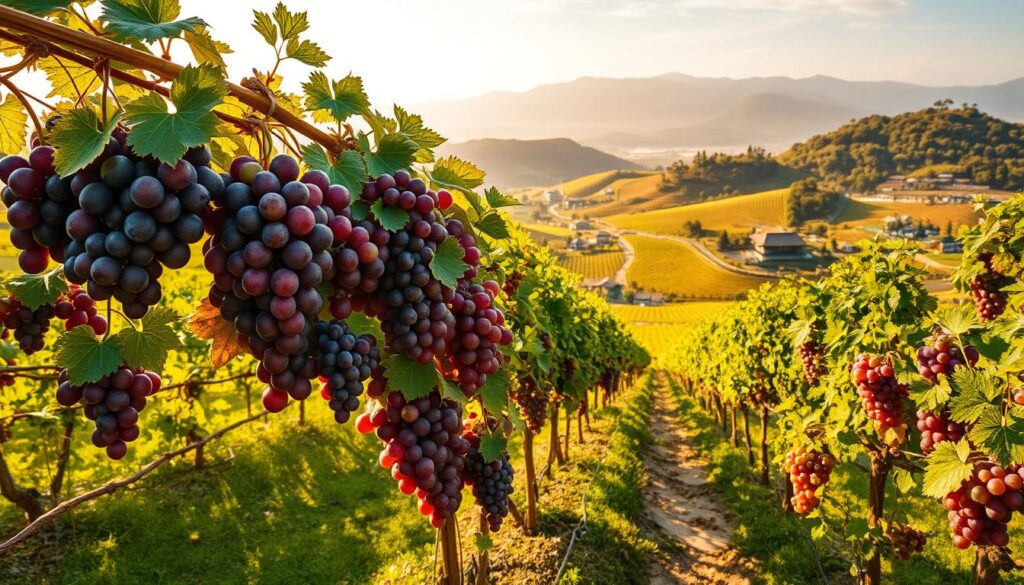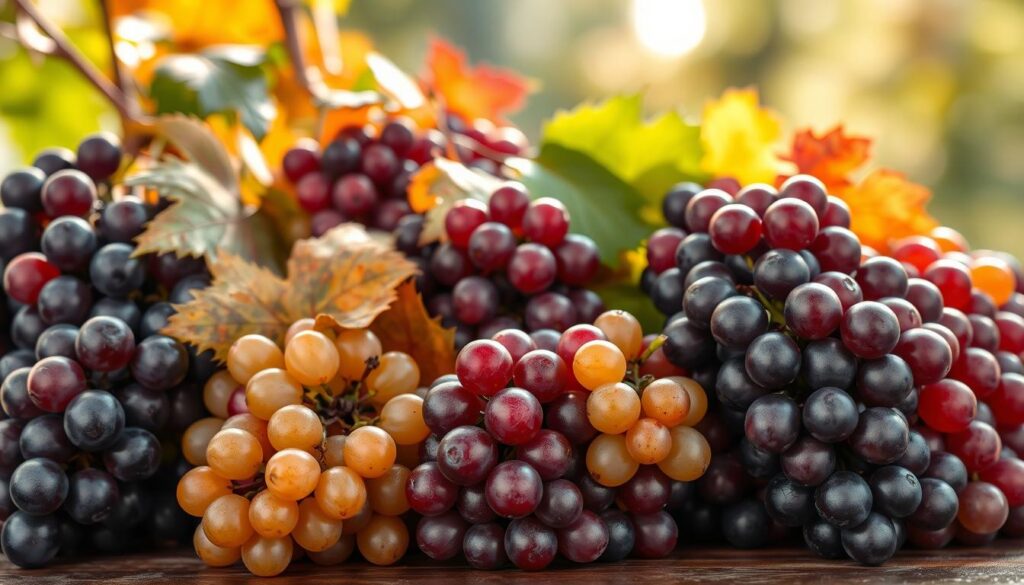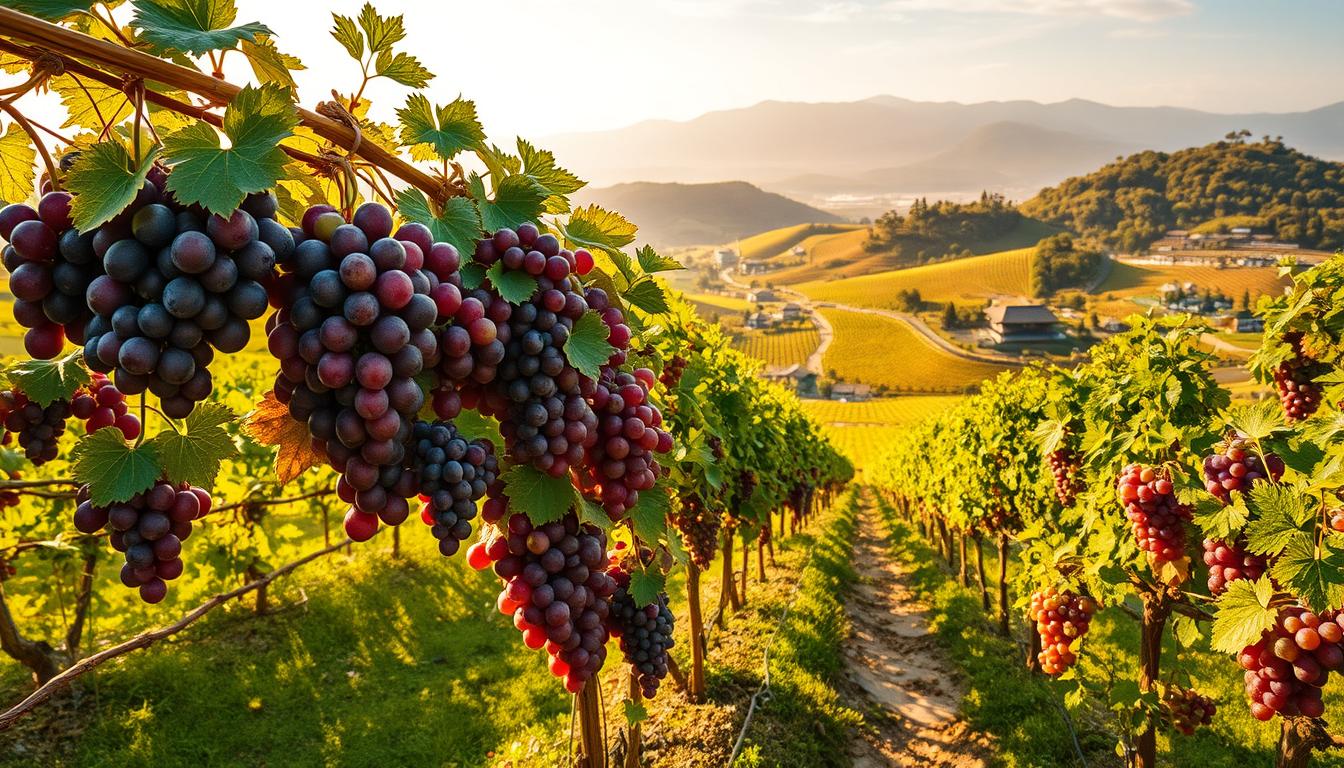Embark on a journey through Japan’s diverse grape varieties, exploring unique flavors and experiences that await travelers. Japan is renowned for its premium table grapes and traditional wine grape varieties, each with a rich history and cultural significance.

From the lush vineyards to the local markets, Japan offers a fascinating world of grapes that are sure to delight any visitor. Discover the different types of grapes you can taste during your trip and learn about the cultivation practices that make Japanese grapes stand out.
Key Takeaways
- Explore Japan’s diverse grape varieties
- Experience premium table grapes and traditional wine grapes
- Learn about the history and culture behind Japan’s grape cultivation
- Discover unique flavors and local grape markets
- Understand the significance of grape cultivation in Japan
Japan’s Unique Grape Culture and History
Japan’s grape culture is a fascinating blend of tradition and innovation. The country’s approach to grape cultivation has been shaped by its history, geography, and cultural practices.
The Evolution of Grape Cultivation in Japan
Grape cultivation in Japan began in the late 19th century, marking the beginning of a long journey towards developing unique grape varieties. Japanese farmers adopted innovative techniques, combining traditional methods with modern technology to create high-quality grapes. This evolution has enabled Japan to produce grapes that are not only delicious but also visually appealing.

What Makes Japanese Grapes Different
So, what sets Japanese grapes apart from others? The answer lies in the meticulous care and attention to detail that Japanese farmers bring to their craft. From careful pruning to precise sugar content management, every step is designed to produce grapes of exceptional quality. As a result, Japanese grapes have gained a reputation globally for their flavor, texture, and appearance.
15 Types of Grapes That You Can Taste in Japan
From sweet treats to luxurious experiences, Japan offers 15 types of grapes to savor. These include premium table grapes and traditional wine grapes, showcasing Japan’s diverse grape culture.
- Premium table grapes like Shine Muscat and Kyoho
- Traditional wine grapes such as Koshu and Muscat Bailey A
- Regional specialties like Pione and Nagano Purple
These varieties are available across different regions in Japan, offering a unique taste experience.

Premium Table Grapes: Japan’s Luxury Fruit Experience
The world of premium table grapes in Japan is a realm of luxury and exquisite taste. Japan is renowned for its meticulous cultivation practices and dedication to quality, making its premium table grapes a sought-after experience for fruit connoisseurs.
Among the varieties that contribute to Japan’s reputation for luxury fruit are the Shine Muscat, Kyoho, Ruby Roman, and Delaware grapes. Each of these varieties offers a unique taste and texture that is cherished by locals and visitors alike.
Shine Muscat: The Emerald Jewel
The Shine Muscat is a premium grape variety known for its bright green color, crunchy texture, and sweet, muscat flavor. This variety is highly prized for its seedlessness and aromatic qualities, making it a favorite among grape enthusiasts.
Kyoho: The Giant Purple Beauty
Kyoho grapes are celebrated for their large size and deep purple color. They are known for their sweet flavor and juicy texture, with a hint of tartness that balances their sweetness. Kyoho grapes are often considered a symbol of luxury and are frequently given as gifts.
Ruby Roman: The Million-Yen Grape
Ruby Roman grapes are among the most luxurious and expensive varieties in Japan, with some bunches selling for over a million yen. They are known for their bright red color, large size, and sweet flavor. The rigorous quality control and limited production make Ruby Roman grapes highly exclusive.
Delaware: The Sweet American Transplant
Delaware grapes, originally from the United States, have been successfully cultivated in Japan and are appreciated for their sweet flavor and small size. They are often eaten fresh and are valued for their taste and texture.
| Grape Variety | Characteristics | Notable Features |
|---|---|---|
| Shine Muscat | Green, crunchy, sweet, muscat flavor | Seedless, aromatic |
| Kyoho | Large, purple, sweet, juicy | Luxurious, symbolic |
| Ruby Roman | Red, large, sweet | Exclusive, high-quality |
| Delaware | Small, sweet | American origin, successfully cultivated in Japan |
Traditional Japanese Wine Grape Varieties
Japan’s wine industry is deeply rooted in its rich cultural heritage, with several traditional grape varieties playing a pivotal role. These varieties have not only adapted to Japan’s unique climate and soil conditions but have also contributed significantly to the country’s wine culture.
Koshu: Japan’s Signature White Wine Grape
Koshu is a white wine grape variety that has been cultivated in Japan for centuries. Known for its delicate flavor and crisp acidity, Koshu wine is a staple in Japanese wine production. It is often described as having notes of citrus and green apple, making it a refreshing choice for wine enthusiasts.
Muscat Bailey A: The Pioneer Red Wine Grape
Muscat Bailey A is a red wine grape variety that was developed in Japan in the early 20th century. It is a cross between the Bailey and Muscat Hamburg varieties, known for its robust flavor and deep color. Muscat Bailey A wines are appreciated for their rich, fruity flavors and are often used in blending to add depth and complexity.
Ryugan: The Dragon’s Eye Grape
Ryugan is another significant grape variety in Japan, known for its high-quality wine production. The name “Ryugan” translates to “Dragon’s Eye,” symbolizing the grape’s potential for producing wines of great character and depth. Ryugan wines are noted for their elegant flavor profiles and aging potential.
Black Queen: The Vintage Favorite
The Black Queen grape variety is a popular choice among Japanese winemakers for its rich, full-bodied wines. Known for its dark fruit flavors and smooth tannins, Black Queen wines are a favorite among those who enjoy robust, complex wines. This variety is often used in premium wine production.
These traditional Japanese wine grape varieties are a testament to the country’s rich wine culture and its ability to produce high-quality wines that are appreciated globally. Whether you’re a seasoned wine enthusiast or just beginning to explore the world of wine, Japan’s traditional grape varieties offer a unique and exciting experience.
- Koshu: Known for its crisp acidity and delicate flavors.
- Muscat Bailey A: Appreciated for its robust flavor and deep color.
- Ryugan: Noted for its elegant flavor profiles and aging potential.
- Black Queen: Favored for its rich, full-bodied wines with dark fruit flavors.
Regional Grape Specialties Across Japan
Japan’s diverse regions are home to a variety of unique grape specialties that reflect local climates, soils, and cultural practices. These regional specialties not only showcase Japan’s rich agricultural diversity but also offer a glimpse into the country’s culinary culture.
Pione: Okayama’s Black Jewel
Pione, known as Okayama’s Black Jewel, is a popular grape variety cultivated primarily in the Okayama prefecture. It is cherished for its large, juicy berries and sweet flavor.
“Pione grapes are a testament to Okayama’s expertise in grape cultivation,”
Takao: The Mountain King Grape
Takao grape is another regional specialty, known for its robust flavor and high quality. Grown in the mountainous regions, Takao benefits from the unique terroir that enhances its taste and texture.
Fujiminori: The Taste of Mt. Fuji
Fujiminori, or “the taste of Mt. Fuji,” is a grape variety that thrives in the shadow of Japan’s iconic mountain. It is celebrated for its crisp texture and refreshing sweetness, making it a favorite among locals and visitors alike.
Nagano Purple: The Alpine Treasure
Nagano Purple is a grape variety that has gained popularity for its deep purple color and rich flavor profile. Grown in the Nagano prefecture, it is often enjoyed as a premium table grape.
Queen Nina: Yamanashi’s Royal Variety
Queen Nina, hailing from Yamanashi, is known for its elegant appearance and succulent taste. This variety is a favorite among grape enthusiasts and is often showcased in local fruit markets.
When and Where to Taste Japanese Grapes
To experience the best of Japan’s grape culture, understanding when and where to taste them is crucial. Japan offers a wide range of grapes throughout the year, with different regions specializing in various types.
Seasonal Availability Guide
Japanese grapes are available from July to November, with peak seasons varying by variety. For instance, Shine Muscat is typically ready in late summer, while Kyoho grapes are at their best in September and October.
Top Grape-Growing Regions to Visit
Some of the top regions for grape cultivation in Japan include Okayama, known for its Pione grapes, and Yamanashi, famous for its Koshu grapes. Visiting these regions can provide a unique insight into Japan’s grape culture.
Fruit Markets, Farms, and Vineyards
To taste Japanese grapes, visitors can explore local fruit markets, visit grape farms, or tour vineyards. Many farms offer grape picking experiences, allowing visitors to enjoy fresh grapes right at the source.
Conclusion: Making the Most of Your Japanese Grape Adventure
As you plan your trip to Japan, you’re now equipped with the knowledge to embark on a thrilling Japanese grape adventure. With 15 unique grape varieties to taste, you’ll discover the country’s rich grape culture and diverse range of grapes available.
From premium table grapes like Shine Muscat and Kyoho to traditional wine varieties such as Koshu and Muscat Bailey A, Japan offers a unique and exciting experience for foodies and wine enthusiasts alike. Be sure to visit top grape-growing regions, fruit markets, farms, and vineyards to indulge in the delightful world of Japanese grapes.
Whether you’re looking to savor the sweetness of Delaware grapes or sample the luxury of Ruby Roman grapes, tasting grapes in Japan is an experience you won’t soon forget. So, get ready to explore the fascinating world of Japanese grapes and make the most of your culinary adventure.
FAQ
What are the most popular grape varieties in Japan?
Japan is known for its premium table grapes, with popular varieties including Shine Muscat, Kyoho, Ruby Roman, and Delaware. Traditional wine grape varieties like Koshu, Muscat Bailey A, Ryugan, and Black Queen are also highly regarded.
When is the best time to taste Japanese grapes?
The best time to taste Japanese grapes varies depending on the variety, but generally, the grape season in Japan is from July to November. Some varieties like Shine Muscat are available as early as June, while others like Ruby Roman are typically harvested in September.
Where can I taste Japanese grapes during my trip?
You can taste Japanese grapes at fruit markets, farms, and vineyards across the country. Top grape-growing regions like Okayama, Yamanashi, and Nagano offer a range of tasting experiences, from sampling fresh grapes at local markets to visiting vineyards and wine cellars.
Are Japanese grapes expensive?
Some premium Japanese grape varieties, like Ruby Roman, can be quite expensive due to their high quality and limited production. However, many other varieties are reasonably priced, making it possible to enjoy a range of Japanese grapes during your trip.
Can I buy Japanese grapes as souvenirs?
Yes, many Japanese grape varieties are available for purchase as souvenirs, either at fruit markets, farm shops, or online. Some popular varieties like Shine Muscat and Kyoho are often packaged as gift boxes, making them a great souvenir option.
How are Japanese grapes cultivated?
Japanese grapes are cultivated using a combination of traditional and modern techniques, with a focus on quality and appearance. Many grape farms in Japan use advanced farming methods, such as bagging and pruning, to produce high-quality grapes.
Can I visit grape farms and vineyards in Japan?
Yes, many grape farms and vineyards in Japan are open to visitors, offering tours, tastings, and other experiences. Some popular regions like Yamanashi and Nagano have a number of vineyards and wineries that welcome visitors.



